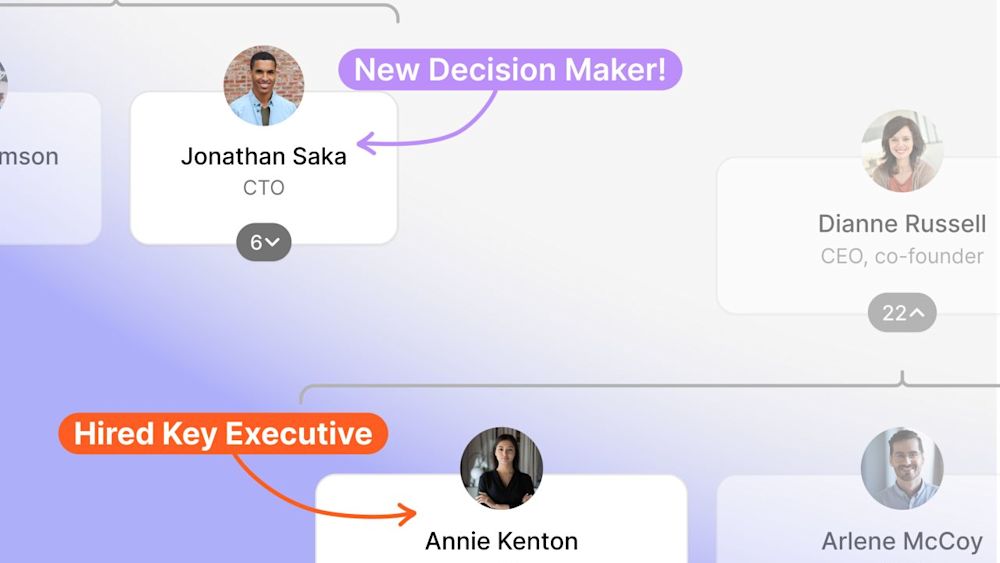Navigating Stakeholders in a Deal Using Org Charts
Table of contents
Learn how to approach the different stakeholders in your selling process using org charts and work with them to close the deal.

Identifying Key Roles
-
Blockers - blockers are individuals who resist change or are opposed to your proposal. They may have valid concerns or might simply be resistant to change for personal or organizational reasons. Blockers can be overt in their opposition or may operate subtly to undermine efforts.
-
Champions - champions are advocates for your product. They believe in your proposal and are willing to support and promote it within the organization. Champions can be instrumental in gaining buy-in from other stakeholders and can help navigate through bureaucratic hurdles.
-
Influencers - influencers hold sway over the decision-making process, often without having formal authority. Their opinions are valued by decision makers, and they can shape perceptions and decisions through their insights and advice.
-
Gatekeepers - gatekeepers control access to decision makers. They can be administrative assistants, advisors, or managers who filter information and control the flow of communication. Building a positive relationship with gatekeepers is essential for gaining access to higher-level decision makers.
Strategies for Engaging Each Role
Engaging Blockers
- Understand Their Concerns: Take the time to understand why they are opposed. This might involve listening to their concerns and addressing them directly.
- Find Common Ground: Identify areas of mutual interest or common goals. Position your proposal in a way that aligns with these shared objectives.
- Involve Them in the Process: Sometimes, involving blockers in the planning or decision-making process can convert them into supporters. It gives them a sense of ownership and can mitigate their resistance.
Leveraging Champions
- Empower Them: Provide champions with the information, resources, and support they need to advocate effectively for your proposal.
- Keep Them Informed: Regular updates and clear communication are key. Ensure they are well-versed in the benefits and progress of your proposal.
- Show Appreciation: Recognize their efforts and contributions. This can be through formal recognition or simple gestures of thanks.
Influencing the Influencers
- Build Relationships: Invest time in building strong, trust-based relationships with influencers. Understand their priorities and how your proposal can help meet them.
- Provide Value: Offer insights, data, and perspectives that can help influencers understand the value of your proposal. Tailor your communication to their interests and concerns.
- Engage Them Early: Involve influencers early in the process to gain their support and advice. Their early endorsement can be pivotal.
Navigating Gatekeepers
- Be Respectful and Professional: Treat gatekeepers with respect and professionalism. They are crucial in facilitating access to decision makers.
- Communicate Clearly: Be clear and concise in your communication. Make it easy for gatekeepers to understand the purpose and importance of your request.
- Build Rapport: Take the time to build a positive relationship with gatekeepers. Personal connections can often open doors that might otherwise remain closed.
Integrating Roles into Your Strategy
Successful navigation of decision makers involves integrating the understanding of these roles into your broader strategy. Here’s how:
-
Map the Stakeholders: Create a stakeholder map that identifies the key players, their roles, and their influence on the decision-making process. This visual representation can help you plan your approach and prioritize your efforts.
-
Tailor Your Communication: Customize your communication strategy for each role. Recognize that what works for a champion might not be effective for a blocker or influencer.
-
Continuous Engagement: Decision-making processes are often dynamic and ongoing. Maintain regular engagement with all key players to stay informed about any shifts in their perspectives or the organizational context.
-
Be Adaptable: Be prepared to adapt your strategy based on the feedback and responses you receive from different decision makers. Flexibility can help you navigate unexpected challenges and capitalize on new opportunities.
--
Navigating decision makers effectively requires a nuanced understanding of the various roles they play and the influence they wield. By identifying blockers, champions, influencers, and gatekeepers, and employing tailored strategies to engage each role, you can enhance your chances of success. Building strong relationships, clear communication, and strategic adaptability are the cornerstones of managing these critical interactions in the business landscape.
Access the world's largest network of public org charts here!


The ÂÜÀòÂÒÂ× helps
you hire great
candidates
Free to use – try today